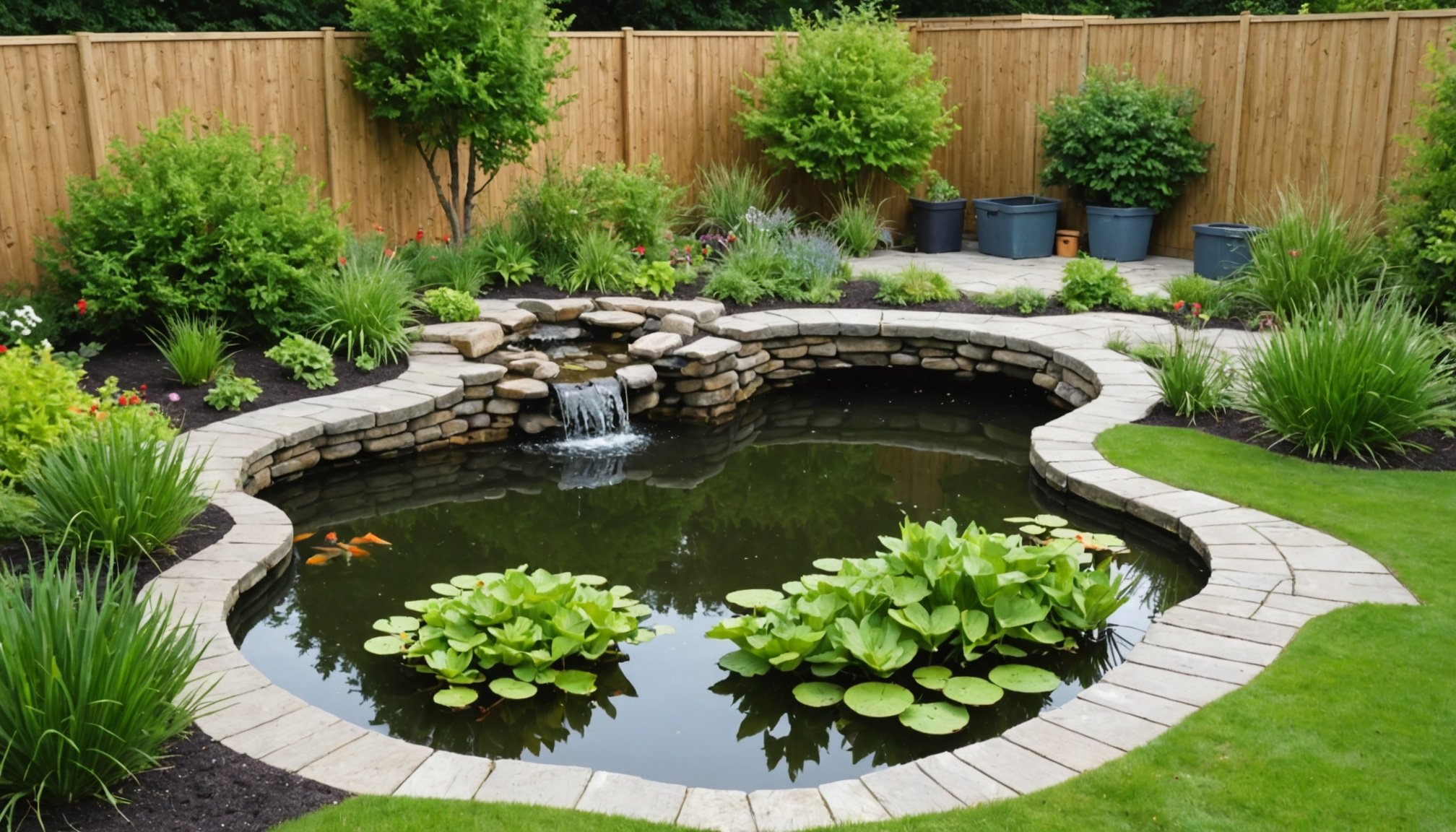Optimal Locations for Garden Ponds in the UK
Choosing the ideal garden pond location requires careful consideration of several factors. Key among these is the balance of sunlight exposure. Aim for a spot that receives a healthy amount of sunlight, but not throughout the entire day. Ideally, the pond should get sunlight for around 4 to 6 hours daily. This amount helps support aquatic plants and prevents the water from overheating, which is crucial for maintaining a stable pond environment.
When placing a pond, consider the existing environment suitability. Avoid locations near trees since fallen leaves can clutter the water and disrupt its ecosystem. Instead, position the pond in a semi-open area that still benefits from some shade provided by structures or smaller plants. This shading can help in regulating the pond’s temperature and preventing algal blooms.
Have you seen this : Essential Tips for Preserving Your Slate Roof in a Picturesque Welsh Village
Additionally, the pond’s proximity to existing garden features and wildlife is vital. A spot near flower beds can create a harmonious landscape, while proximity to hedges or other natural barriers can encourage visits from local wildlife. This interaction not only enhances the aesthetic appeal of your garden but also supports a diverse ecosystem within and around the pond.
Choosing the right location, balancing sunlight, and considering existing features and wildlife can transform your pond into a thriving outdoor sanctuary.
Also to read : Maximizing Space: Top Strategies for Organizing Digital Home Entertainment in a Cozy Swansea Flat
Seasonal Considerations for Installing a Garden Pond
Understanding the best time of year to install a garden pond in the UK can greatly influence the success of your pond ecosystem. Timing the installation can be crucial due to the unique UK climate and seasonal weather patterns.
Spring to early summer often emerges as the most suitable period for pond installation timing. During this time, the weather is typically stable, and the risk of frost is minimal, which is beneficial for the pond’s structural establishment. Furthermore, installing a pond during this period allows aquatic plants to settle and thrive, building a robust pond ecosystem.
The UK climate also poses specific challenges. Heavy rainfall in autumn can disrupt pond construction, while winter’s freezing temperatures can hinder pond ecosystem development. Considering these factors can ensure that the pond withstands seasonal changes and encourages a balanced aquatic environment.
In addition, the seasonal effects on pond ecosystem development cannot be overlooked. For instance, installing during warmer months allows sunlight to penetrate the water effectively, promoting photosynthesis and the growth of beneficial bacteria. These elements contribute positively to the pond’s health and vitality, setting a strong foundation for thriving aquatic life.
Soil Preparation for Pond Installation
Preparing the soil is a vital step in pond construction. It ensures that the pond functions effectively and maintains its water retention. The first task is assessing the soil type. This helps in understanding the drainage capabilities and the potential need for amendments. Different soil types, like clay or sandy soil, affect how water is retained or drained. Clay, for instance, has high water retention but poor drainage, whereas sandy soil drains well but holds less water.
Understanding your soil type can help you determine what adjustments might be necessary. If your soil struggles with water retention, consider adding soil amendments. Materials like bentonite clay or pond liners can help improve retention and create a more stable environment for your pond.
When preparing the ground, techniques such as compacting and grading are essential. These procedures shape the pond structure and ensure that the water is held efficiently. Compacting stabilises loose soil, while grading levels the surface, creating an even base.
With proper soil preparation, you can ensure pond health and longevity, creating an ecosystem that not only retains water effectively but also supports aquatic life sustainably.
Recommendations for Pond Size and Depth
Pond sizing is crucial to maintaining a healthy ecological balance. Understanding the factors that influence size selection can help create an environment where both local wildlife and plants thrive. When deciding on the appropriate size for your pond, consider the available land area, the purposes of the pond (such as wildlife habitat or aesthetic enjoyment), and the desired biodiversity.
Depth guidelines vary depending on the type of pond you wish to establish. For most garden ponds, a depth of 60 cm to 1 meter is ideal. This range supports diverse aquatic life while preventing issues like overgrowth of algae. For koi ponds, deeper waters of at least 1 meter are recommended to accommodate the fish and maintain water quality.
The impact of your pond’s size on local wildlife and plants is significant. Larger bodies of water can support a wider array of species, providing habitats for birds, insects, and amphibians. Moreover, a well-balanced pond size encourages the growth of beneficial plants, which contribute to water filtration and oxygenation, striking a synergistic ecological balance. Considering these guidelines helps you create a vibrant and sustainable aquatic ecosystem.
Regulatory Issues Surrounding Garden Ponds
Creating a garden pond in the UK comes with specific pond regulations that need to be understood for a smooth project. Knowing these rules can save you from potential legal challenges. Generally, garden ponds that hold less than 5000 litres do not typically require planning permissions. However, if you plan to introduce significant land changes or if your property is listed, it’s best to check with your local authority.
Planning permissions are crucial when your pond might impact local ecosystems or when it involves excavation. For ponds on properties near protected areas, such as nature reserves, additional consent may be needed. It’s important to assess if your pond could affect wildlife habitats, ensuring that you adhere to environmental considerations.
Legal requirements also extend to safety measures, particularly if children will have access to the pond. Fencing or a pond cover might be necessary to prevent accidents, aligning with your legal responsibilities. Being aware of these regulations not only helps in reducing environmental impact but also in fostering a safe community setting. Remember, seeking professional advice can offer further clarity on specific scenarios related to your garden pond ambitions.
Maintenance Practices for Garden Ponds
Ensuring the longevity of your garden pond begins with consistent pond maintenance. Regular upkeep not only enhances the aesthetic appeal but also supports a balanced ecosystem. Key tasks include debris removal, filter cleaning, and checking pump functionality. By attending to these duties, you’ll prolong the life of your pond and maintain its vibrancy.
Water quality management is central to sustaining a healthy pond environment. It involves regularly testing the pH balance, ammonia, and nitrate levels, which are crucial for aquatic life. Balancing these elements is essential for maintaining clear water, reducing algae blooms, and preventing fish illness. Installations like a UV clarifier can assist in keeping your pond water crystal clear.
Adapting maintenance routines to the seasons aids in maintaining water quality throughout the year. During spring and summer, encourage plant growth and monitor evaporation. In contrast, autumn prep is vital—net the pond to catch falling leaves. Winter care involves circulation checks to prevent freezing. Tailoring your seasonal care will accommodate diverse climate conditions, ensuring pond stability year-round.
Selecting Plants for UK Garden Ponds
Choosing the right aquatic plants for your UK garden pond is essential for creating a thriving and resilient ecosystem. Native flora plays a pivotal role in enhancing the pond’s biodiversity, providing a habitat for wildlife, and maintaining water quality. Embracing native plants ensures that your pond naturally integrates with the surrounding environment and supports local fauna.
When selecting aquatic plants, it is crucial to consider UK climates to ensure compatibility and sustainability throughout the seasons. Some recommended native species include Iris pseudacorus (Yellow Flag Iris), Nymphaea alba (White Water Lily), and Myosotis scorpioides (Water Forget-me-not), each offering various ecological benefits and beauty. Yellow Flag Iris, for example, can boost biodiversity by attracting pollinators, while Water Lily serves as fantastic shade, lowering algae growth.
Balancing aesthetic choices with ecological needs can be achieved by mixing flowering species with foliage-based plants like Potamogeton natans (Broadleaf Pondweed). This combination creates a visually pleasing pond and promotes varied wildlife. Ultimately, selecting the right mix helps establish a harmonious ecosystem, supporting both the natural beauty of your garden and its ecological vitality.











